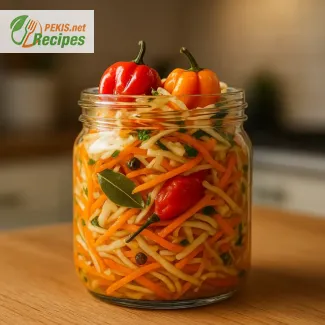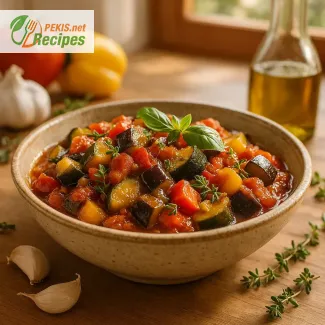
A Scandinavian Midsummer Delight Reimagined for Modern Tables
Discover the timeless appeal of Sweden’s festive herring cake, a culinary centerpiece for summer gatherings
There are few dishes that capture the essence of Swedish summer traditions as vividly as the Swedish Herring Cake, locally known as Silltårta. This elegantly layered savory cake is not a dessert but a flavorful cold-smoked fish delicacy, combining the richness of pickled herring, the creaminess of dairy-based toppings, and the freshness of dill, chives, and vegetables into a striking, cake-like presentation. Served chilled and decorated with seasonal herbs and sliced vegetables, it is a staple at Midsummer feasts, family brunches, and seaside buffets.
Unlike more commonly known Scandinavian dishes, Silltårta remains a hidden gem beyond Swedish borders. Yet its unique composition and striking aesthetic make it one of the most photogenic and conversation-starting centerpieces on any table. With Nordic cuisine gaining global interest, the Swedish Herring Cake is being rediscovered by food enthusiasts for its combination of heritage, freshness, and boldness.
A celebration of Sweden’s seasonal ingredients
What makes Silltårta stand out is its focus on seasonal, local ingredients—a culinary hallmark of Nordic tradition. The base is typically made from soft rye bread or white sandwich bread, layered with a whipped mixture of crème fraîche, mayonnaise, and finely chopped red onion, herbs, and pickled herring. The top is then carefully adorned with cucumber ribbons, sliced radishes, boiled eggs, dill sprigs, and sometimes even salmon roe.
Each bite is refreshingly creamy, lightly acidic, and balanced with the salty umami of the fish. The contrast of textures—smooth mousse, soft bread, and crisp toppings—creates a dynamic sensory experience, especially when served slightly chilled on a warm summer afternoon.
Midsummer and beyond: when to serve Silltårta
While the Swedish Midsummer celebration is the most iconic setting for serving this dish, Silltårta fits seamlessly into many occasions. It can serve as an appetizer, a main dish in a cold buffet, or even a visually stunning starter for festive dinners. It’s particularly popular at birthdays, weddings, and outdoor events where light, no-bake dishes are ideal.
The cold preparation makes it perfect for make-ahead menus and easy transport, and it’s best served after at least a few hours in the fridge so that the layers can set and the flavors meld. For caterers and home cooks alike, this dish offers a smart and elegant solution for seasonal entertaining.
A fusion of tradition and presentation
Visually, the herring cake resembles a savory version of a layer cake or even a Scandinavian take on the classic smörgåstårta (Swedish sandwich cake). What differentiates it is the emphasis on herring and herb-based fillings, with less focus on deli meats or pâtés. In fact, it is not uncommon to see Silltårta decorated with edible flowers and carefully piped crème fraîche borders, giving it the look of a culinary showpiece worthy of a holiday table.
Although rooted in classic Swedish cuisine, the dish offers immense room for personalization and regional adaptation. Some variations incorporate beetroot for a pink-hued filling, others use horseradish for extra bite, and coastal families might add smoked salmon or trout for a more luxurious twist.
Perfect pairing suggestions
To complement the bold flavors of the herring cake, it is traditionally paired with aquavit, dry white wine, or even a crisp lager. On the side, you might find boiled new potatoes, gravad lax, or sour cream with chives—a testament to the Nordic approach of simple, clean combinations that let each ingredient shine.
For international audiences unfamiliar with herring, it may be helpful to think of this as a seafood mousse cake—complex in taste but incredibly refreshing and light. And despite its ornate appearance, it is surprisingly easy to prepare, requiring no baking and just a few hours of chilling time.
From tradition to trend
As interest grows in fermented, preserved, and sustainable ingredients, the Swedish Herring Cake aligns perfectly with today’s culinary movements. Herring is not only a sustainable fish source but also rich in history, flavor, and cultural symbolism. Incorporating it into a modern dish that balances visual appeal, heritage, and taste offers a meaningful way to explore Sweden’s culinary story.
Whether you’re planning a Midsummer party, a Nordic-themed dinner, or simply looking for a unique dish to serve at your next brunch, Silltårta is an authentic and stunning choice that’s sure to leave an impression. Its visual charm and robust flavor profile make it a conversation starter on any summer table.
1. Prepare the filling
Soften the gelatin sheets in cold water for 5–7 minutes. Meanwhile, in a large bowl, mix together crème fraîche, sour cream, mayonnaise, chopped red onion, dill, chives, lemon juice, salt, and pepper. Fold in the finely chopped pickled herring.
Drain and gently heat the gelatin until melted, then stir it into the filling mixture thoroughly. Chill the mixture in the refrigerator for 10 minutes to slightly firm.
2. Prepare the bread base
Trim the crusts off the sandwich bread slices and line a springform cake tin (22–24 cm / 9 inches) with a single layer of bread. Cut pieces to fit as needed, covering the base completely.
3. Layer the cake
Spread one-third of the herring filling over the first bread layer. Add a second layer of trimmed bread, then another third of the filling. Repeat until the filling is used up, ending with a bread layer on top. Cover with plastic wrap and refrigerate for at least 2 hours (or overnight) to allow the cake to set fully.
4. Decorate
Once the cake is firm, remove it from the tin and place it on a serving dish. Use cucumber ribbons to cover the sides decoratively. Arrange sliced radishes, hard-boiled eggs, dill sprigs, and optional salmon roe on top for a fresh summer look. Serve chilled.
Creative Upgrades to a Classic Scandinavian Celebration Dish
Tips to modernize, personalize, and elevate the traditional Swedish herring cake (Silltårta)
The Swedish Herring Cake, or Silltårta, is a dish grounded in tradition, often served during Midsummer feasts and family gatherings. Yet like many time-honored recipes, it provides plenty of room for refinement, creativity, and improved balance of flavor, texture, and nutrition. Whether you're preparing this cake for the first time or aiming to impress seasoned guests with a more refined version, a few expert modifications can turn this savory centerpiece into a truly memorable dish.
Experiment with protein variations
While pickled herring is essential for authenticity, not everyone enjoys its robust and vinegary flavor. For a milder seafood note, try blending it with cold-smoked salmon or hot-smoked mackerel, which softens the tang and brings in a delicate smokiness. Replacing part of the herring with gravad lax adds a touch of sweetness, while maintaining the Nordic identity.
For pescatarian guests or flavor balance, a 50:50 ratio of herring and trout works especially well, adding richness and body without overwhelming the palate.
Boost freshness and texture with vegetables
A common mistake in preparing Silltårta is neglecting textural contrast. Soft bread and creamy fillings need crisp, refreshing elements. Add finely chopped celery, green apple, or pickled cucumber to the filling for a subtle crunch. Thinly sliced fennel or spring onion lends brightness, while also enhancing digestibility.
To reduce heaviness, swap half the mayonnaise with Greek yogurt, which offers a tangy freshness and reduces the overall fat content. You can also use low-fat crème fraîche without compromising the creamy texture.
Rethink your bread base
The bread is often overlooked, yet it forms the foundation of every layer. Choose a dense, unsweetened rye or lightly sourdough wheat bread rather than generic white sandwich slices. The extra structure and flavor prevent sogginess and enhance overall integrity. Lightly toasting the slices before layering can further protect against moisture seepage, especially if the cake will be chilled for more than a few hours.
For a gluten-free alternative, opt for gluten-free oat bread, which tends to hold shape well and pairs naturally with creamy and fishy components.
Build flavor depth with aromatic accents
Herbs are essential in this recipe, but many limit themselves to dill and chives. Introduce tarragon, lemon balm, or parsley for complexity. A pinch of white pepper, grated horseradish, or even a small amount of wasabi in the filling can create a subtle warmth that cuts through the fat and intensifies flavor without overshadowing the fish.
Adding grated lemon zest instead of just juice provides essential oils from the peel, lifting the filling and adding brightness.
Toppings that do more than decorate
Toppings shouldn’t be merely aesthetic. While cucumber ribbons, radish slices, and boiled egg halves are classic, they can be elevated with pickled red onions, capers, or microgreens. Fresh edible flowers, such as pansies or chive blossoms, add visual appeal while remaining edible and aromatic.
For extra indulgence, finish with a spoonful of trout roe or whitefish caviar. This creates umami-rich bursts that amplify the seafood profile and lend a festive elegance.
Chill time and assembly discipline
Another common misstep is under-chilling the cake before serving. Letting it rest in the fridge for at least 2–3 hours, preferably longer, ensures that the gelatin sets and the flavors merge into a cohesive taste. Wrap the cake tightly with cling film while chilling to maintain shape and prevent drying.
If preparing in advance, keep decorative toppings separate until the final hour before serving. This preserves freshness and texture, especially for herbs and crisp vegetables.
Make it lighter without sacrificing flavor
To adapt this dish for health-conscious eaters, consider reducing the fat content by using low-fat dairy options and increasing the herb-to-sauce ratio for flavor. You can also include steamed vegetables, such as finely chopped carrots or zucchini, to bulk up the filling with nutrients and fiber.
Instead of salt, let the brininess of the herring and the acidity of the lemon provide the seasoning. Adding a splash of apple cider vinegar to the filling can also mimic the zing of traditional herring while enhancing digestive support.
The case for homemade over store-bought
Creating the dish at home ensures control over salt levels, quality of fish, and the use of fresh, seasonal herbs. Many commercial versions contain added preservatives, excessive mayonnaise, or poorly balanced acidity. Homemade preparation allows for tailored adjustments, fresher flavor, and presentation that reflects personal culinary style.
Additionally, preparing the filling from scratch ensures the right consistency—not too runny, not too thick. Pre-mixed spreads often lack the structure needed to hold cake layers together over time.
Presentation makes a difference
Using a removable-bottom cake tin gives the dish clean edges and a professional finish. Line the tin with plastic wrap for easier unmolding. Garnish symmetrically, using color contrasts such as green herbs, red radish, and golden yolks to guide the eye across the top. Even spacing and repetition in decoration give the cake a refined, intentional appearance.
With these refinements, the Swedish Herring Cake can evolve from a rustic Midsummer staple into a modern gourmet centerpiece—one that honors tradition while embracing innovation and personal flair.
Allergens present in the recipe:
- Fish (herring)
- Eggs (in mayonnaise and topping)
- Milk (crème fraîche, sour cream)
- Gluten (bread)
Tips for replacing allergens and gluten:
- Replace pickled herring with marinated tofu or smoked tempeh for a fish-free version.
- Use plant-based mayonnaise and plant-based sour cream to make it egg- and dairy-free.
- Use gluten-free sandwich bread to make it suitable for gluten-sensitive individuals.
Vitamins and minerals per serving (approximate):
- Vitamin D: 3.5 µg – supports immune health and calcium absorption
- Vitamin B12: 2.4 µg – essential for nervous system and red blood cell production
- Vitamin A: 120 µg – promotes eye and skin health
- Calcium: 95 mg – supports bone and dental health
- Iron: 1.1 mg – contributes to oxygen transport and energy levels
- Magnesium: 30 mg – supports muscle and nerve function
- Potassium: 300 mg – helps regulate blood pressure
- Selenium: 25 µg – powerful antioxidant and supports thyroid function
- Zinc: 1.6 mg – important for immune system and wound healing
Antioxidants per serving (approximate):
- Vitamin C (from lemon juice, cucumber, radishes): 6 mg – boosts immunity and skin collagen
- Quercetin (from onions): 15 mg – supports cardiovascular health and has anti-inflammatory effects
- Lutein (from eggs and radishes): 200 µg – promotes eye health and reduces oxidative stress
- Beta-carotene (from dill and herbs): 300 µg – converts to vitamin A and supports vision and skin health





